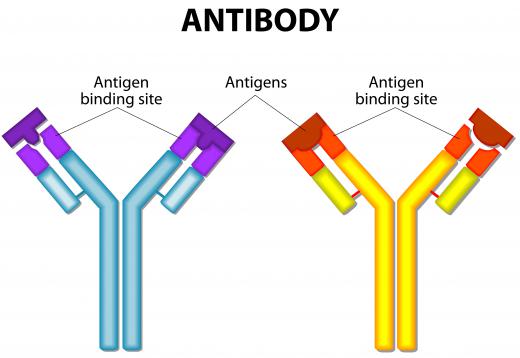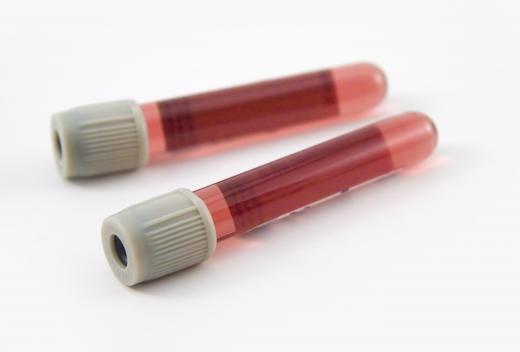What Is Agglutination?
In biology, agglutination refers to the bunching together of particles. This process is especially important as part of the immune system, the response process that an organism uses to fight disease. Hemagglutination, the clumping of red blood cells, has special applications in medicine, where it is used to determine blood type and find the concentration of infecting viruses or bacteria in the bloodstream.
Foreign bacteria or viruses entering the body contain specific components called antigens, which trigger an immune response in the host. White blood cells in the body produce proteins known as antibodies in response to the presence of antigens. The antibodies bind with the antigens through a structural mechanism similar to a key and a lock, and can either neutralize the antigen directly or mark it for destruction by the immune system.

Agglutination is one way in which antibodies mark antigens for destruction. Antibodies have at least two sites where an antigen can bind, so they are capable of binding with more than one bacterium or virus. When this happens, the invading particles begin to agglutinate, or form clumps, through a network of antibodies. The clumps eventually become too large to remain in solution in the bloodstream, and precipitate out of solution.

Once the clumps of particles are large enough, they become easy prey for phagocytes — a type of white blood cell that ingests foreign material. Phagocytes ingest and break down the clump, neutralizing the threat of disease. In this way, agglutination enables the body to disarm and remove harmful invading particles.
Hemagglutination, by contrast, is not a naturally occurring process in the body but is instead used to perform assays and testing procedures in molecular biology. Blood type is determined through this process. In blood typing, specific antibodies are added that bind to specific types of red blood cells. If the antibody binds to the red blood cells in a sample, agglutination occurs, and blood type can be confirmed based on which antibody was used.
The concentration of bacteria or viruses in a sample can sometimes be determined using a test called a hemagglutination assay. Certain bacteria and viruses contain compounds that allow them to bind to red blood cells, creating a clump network. In the assay, a diluted sample of virus is added to a diluted blood cell sample, and agglutination is allowed to occur for about 30 minutes. The concentration of the virus can be determined by counting the number of clumps or lattices formed in the mixed sample.
AS FEATURED ON:
AS FEATURED ON:












Discussion Comments
The other name of agglutination, which I think is a difficult word, is the Gruber-Durham reaction. It's named after the scientists Max von Gruber and Herbert Edward Durham who discovered this clumping mechanism.
I knew that this was a method that is used before blood transfusions to make sure that two blood types match, but I didn't realize what it meant until now. This is a helpful article, thanks!
@bluedolphing-- Yes, you understood it correctly. It's the antibodies that pull them together and join them so that the white blood cells can basically consume them and get rid of them. This not only allows many invaders to be destroyed at once, but it also makes it easier for phagocytes to find them.
It's not only invading pathogens that clump together though. Sometimes regular cells agglutinate to sort of create a barrier and keep foreign materials out. For example, cells might do this to protect from a foreign material that the body is allergic to.
Either way, it's part of the immune system response.
This is a very interesting concept. I'm just a little confused about one thing. Do invading pathogens agglutinate because antibodies pull them together? How does binding to more than one pathogen make them clump?
Post your comments